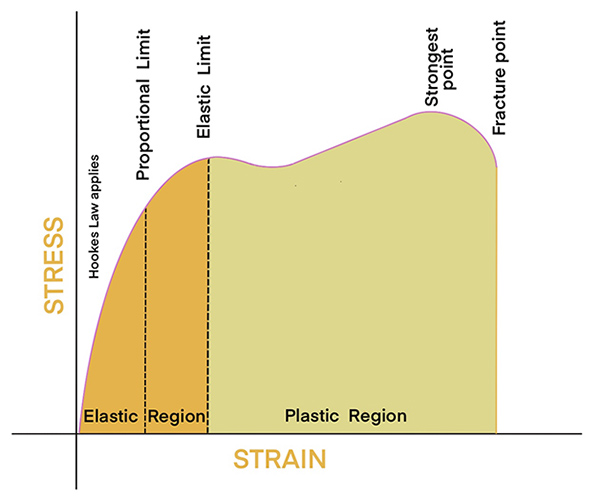Plasticity in construction
The term 'plasticity' refers to the degree to which as material has the characteristic of being easily shaped, moulded or formed. More specifically in terms of material science and building physics it relates to the terms plastic region and plastic deformation - where a material is unable to retain elasticity (return to its original shape), or as such has the ability to undergo permanent deformation in response to forces being applied. It is the middle stage of the characteristic behaviour of materials under stress and strain from forces being applied, the first stage being elasticity and the last stage being fracture or failure.
It is important to note that plasticity refers to a materials characteristics rather than being a reference to a particular type of material, such as plastic.
For example, natural clay has the characteristic of plasticity because it can be moulded into any shape, but also wood can have the characteristic of plasticity, where timber beams for example over years become permanently bowed but retain their strength and do not reach fracture point.
Plastics may also posses plasticity as a characteristic when they are heated and moulded into for example building components.
The level that a material can sustain plastic deformation under tensile force is referred to as ductility, whilst a material's ability to deform plastically without failing under compressive stresses is referred to as malleability.
A material that has a very small plastic region and potentially elastic region also is referred to as brittle.
[edit] Related articles on Designing Buildings
Featured articles and news
BSRIA Sentinel Clerk of Works Training Case Study
Strengthening expertise to enhance service delivery with integrated cutting-edge industry knowledge.
Impact report from the Supply Chain Sustainability School
Free sustainability skills, training and support delivered to thousands of UK companies to help cut carbon.
The Building Safety Forum at the Installershow 2025
With speakers confirmed for 24 June as part of Building Safety Week.
The UK’s largest air pollution campaign.
Future Homes Standard, now includes solar, but what else?
Will the new standard, due to in the Autumn, go far enough in terms of performance ?
BSRIA Briefing: Cleaner Air, Better tomorrow
A look back at issues relating to inside and outside air quality, discussed during the BSRIA briefing in 2023.
Restoring Abbotsford's hothouse
Bringing the writer Walter Scott's garden to life.
Reflections on the spending review with CIAT.
Retired firefighter cycles world to raise Grenfell funds
Leaving on 14 June 2025 Stephen will raise money for youth and schools through the Grenfell Foundation.
Key points for construction at a glance with industry reactions.
Functionality, visibility and sustainability
The simpler approach to specification.
Architects, architecture, buildings, and inspiration in film
The close ties between makers and the movies, with our long list of suggested viewing.
SELECT three-point plan for action issued to MSPs
Call for Scottish regulation, green skills and recognition of electrotechnical industry as part of a manifesto for Scottish Parliamentary elections.
UCEM becomes the University of the Built Environment
Major milestone in its 106-year history, follows recent merger with London School of Architecture (LSE).
Professional practical experience for Architects in training
The long process to transform the nature of education and professional practical experience in the Architecture profession following recent reports.
A people-first approach to retrofit
Moving away from the destructive paradigm of fabric-first.
New guide for clients launched at Houses of Parliament
'There has never been a more important time for clients to step up and ...ask the right questions'
The impact of recycled slate tiles
Innovation across the decades.
EPC changes for existing buildings
Changes and their context as the new RdSAP methodology comes into use from 15 June.



























Comments
[edit] To make a comment about this article, or to suggest changes, click 'Add a comment' above. Separate your comments from any existing comments by inserting a horizontal line.